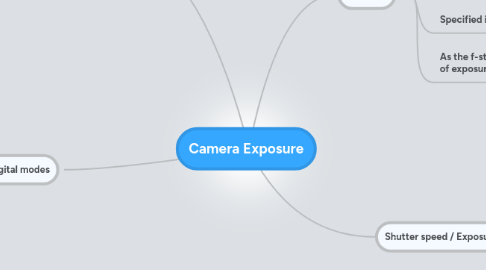Camera Exposure
Door Alix Scarlatos


1. ISO speed
1.1. "Quantity" aspect
1.2. Controls sensitivity to exposure
1.3. (Film grain or extra volume on an otherwise smooth image surface)
1.3.1. Affects image noise
1.4. Common speeds: 100, 200, 400, 800
1.4.1. Lower ISO speed typically desired
1.4.2. The higher the ISO speed, the more image noise.
2. Other standardized digital modes
2.1. Auto selects all exposure settings
2.1.1. Auto (a green rectangle)
2.2. Auto selects aperture and shutter speed
2.2.1. Program (P)
2.3. Auto determines corresponding shutter speed to your selected aperture & ISO
2.3.1. Aperture Priority (AV or A)
2.4. Auto determines corresponding aperture to your selected shutter speed & ISO
2.4.1. Shutter Priority (TV or S)
2.5. Self specify aperture, ISO and shutter speed
2.5.1. Manual (M)
2.6. For exposures longer than 30 seconds; self specify aperture & ISO, shutter speed is auto determined by a remote release switch
2.6.1. Bulb (B)
3. Shutter speed / Exposure time
3.1. "Time" aspect
3.2. Controls duration of exposure
3.2.1. 1 - 30+ seconds: Specialty low-light photos
3.2.2. 1/2 to 1/30 seconds: Adds motion blur to backgrounds of moving subjects
3.2.3. 1/250 to 1/500 seconds: To freeze subject motion
3.3. Faster shutter speed, shorter exposure time
3.4. Affects motion blur
3.4.1. (The possibility of an unclear focused image)
3.5. Simplest of the 3 camera settings
4. Aperture
4.1. "Width" aspect
4.2. Controls area of allowed exposure
4.3. Affects depth of field
4.3.1. Lower aperture, shallower depth of field
4.4. Specified in terms of "f-stop"
4.4.1. "Stopping down", "opening up" refer to f-stop value
